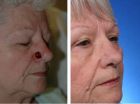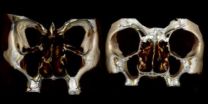(Press-News.org) New Rochelle, NY, March 12, 2013—The foodborne bacteria Listeria monocytogenes sickens about 2,500 people in the U.S. each year and many more worldwide, killing about 25-30% of those infected. Listeriosis is caused by eating food contaminated with L. monocytogenes, and current methods for detecting the bacteria are costly and time consuming. An innovative nanotechnology-based method for developing an inexpensive biosensor to detect the pathogen in food is described in Industrial Biotechnology, a peer-reviewed journal from Mary Ann Liebert Inc., publishers (http://www.liebertpub.com). The articles are available free on the Industrial Biotechnology (http://www.liebertpub.com/ind) website.
Vivian C.H. Wu, PhD led a group of scientists from University of Maine (Orono), National Chio Tung University, and Apex Biotechnology Corp. (Hsinchu, Taiwan), in producing a highly specific, antibody-based immunobiosensing strip with the potential for low-cost commercial development. Danielle Davis, et al. describes their work in the article "Gold Nanoparticle-Modified Carbon Electrode Biosensor for the Detection of Listeria monocytogenes (http://online.liebertpub.com/doi/full/10.1089/ind.2012.0033)."
The article is part of an IB Special Section on Nanobiotechnology, Part 2, led by Co-Guest Editors Norman Scott, PhD, Professor, Cornell University (Ithaca, NY) and Hongda Chen, PhD, National Program Leader, National Institute of Food and Agriculture, USDA (Washington, DC). In their Overview article "Nanoscale Science and Engineering for Agriculture and Food Systems (http://online.liebertpub.com/doi/full/10.1089/ind.2013.1555)," they describe the emerging opportunities and challenges for nanotechnology and nanomaterials research in industrial biotechnology.
The special section also includes two Review articles: "Time Analysis of Poly(Lactic-Co-Glycolic) Acid Nanoparticle Uptake by Major Organs Following Acute Intravenous and Oral Administration in Mice and Rats (http://online.liebertpub.com/doi/full/10.1089/ind.2012.0032)" by Lacey Simon and Cristina Sabliov, Louisiana State University (Baton Rouge, LA); and "Biomarker-Based Nanotechnology for the Improvement of Reproductive Performance in Beef and Dairy Cattle (http://online.liebertpub.com/doi/full/10.1089/ind.2012.0035)" by Peter Sutovsky and Chelsey Kennedy, University of Missouri-Columbia, MO.
Additional original research articles include "Pueraria lobata (Kudzu) Photosystem I Improves the Photoelectrochemical Performance of Silicon (http://online.liebertpub.com/doi/full/10.1089/ind.2012.0036)" by Darlene Gunther, Gabriel LeBlanc, David Cliffel, and G. Kane Jennings, Vanderbilt University (Nashville, TN); and "An Aptasensor Based on Polymer-Gold Nanoparticle Composite Microspheres for the Detection of Malathion Using Surface-Enhanced Raman Spectroscopy (http://online.liebertpub.com/doi/full/10.1089/ind.2012.0029)" by Francisco Barahona, Cameron Bardliving, Adrienne Phifer, John Bruno, and Carl Batt, Cornell University (Ithaca, NY) and Operational Technologies Corp. (San Antonio, TX).
"Nanoscale science continues to play a major role in catalyzing biotechnology innovation, yielding a broad spectrum of devices and products that are addressing many pressing social needs," says Larry Walker, PhD, Co-Editor-in-Chief and Professor, Biological & Environmental Engineering, Cornell University, Ithaca, NY.
INFORMATION:
About the Journal
Industrial Biotechnology (http://www.liebertpub.com/ind), led by Co-Editors-in-Chief Larry Walker, PhD, and Glenn Nedwin, PhD, MBA, is an authoritative journal focused on biobased industrial and environmental products and processes, published bimonthly in print and online. The Journal reports on the science, business, and policy developments of the emerging global bioeconomy, including biobased production of energy and fuels, chemicals, materials, and consumer goods. The articles published include critically reviewed original research in all related sciences (biology, biochemistry, chemical and process engineering, agriculture), in addition to expert commentary on current policy, funding, markets, business, legal issues, and science trends. Industrial Biotechnology offers the premier forum bridging basic research and R&D with later-stage commercialization for sustainable biobased industrial and environmental applications.
About the Publisher
Mary Ann Liebert Inc., publishers (http://www.liebertpub.com) is a privately held, fully integrated media company known for establishing authoritative peer-reviewed journals in many promising areas of science and biomedical research, including Environmental Engineering Science and Sustainability: The Journal of Record. Its biotechnology trade magazine, Genetic Engineering & Biotechnology News (GEN), was the first in its field and is today the industry's most widely read publication worldwide. A complete list of the firm's 70 journals, books, and newsmagazines is available on the Mary Ann Liebert Inc., publishers (http://www.liebertpub.com) website.
Low-cost nano-biosensor to detect foodborne pathogen that causes listeriosis
Described in Industrial Biotechnology
2013-03-12
ELSE PRESS RELEASES FROM THIS DATE:
Repairing the nose after skin cancer in just one step
2013-03-12
ANN ARBOR, Mich. — The skin cancer growing on Carolyn Bohlmann's nose was not a very aggressive variety. But it was deep and located right on her nostril. The tricky part was not so much removing it – MOHS surgery, the procedure Bohlmann had, is a fairly common outpatient procedure.
The tricky part would be reconstructing her nostril so that it didn't lift up or droop down. It's an important cosmetic issue, but it's also critical for breathing.
Bohlmann opted for a new reconstruction technique her surgeon, Jeffrey Moyer, M.D., was offering at the University of Michigan ...
Cryptic clams: U-M biologists find species hiding in plain view
2013-03-12
ANN ARBOR— Cryptic comments seem to have an ambiguous, obscure or hidden meaning. In biology, cryptic species are outwardly indistinguishable groups whose differences are hidden inside their genes.
Two University of Michigan marine biologists have identified three cryptic species of tiny clams, long believed to be members of the same species, which have been hiding in plain view along the rocky shores of southern Australia for millions of years.
The unusual convergence of a climate-cooling event and the peculiarities of local geography caused the three cryptic species ...
Havoc in biology's most-used human cell line
2013-03-12
HeLa cells are the world's most commonly used human cell lines, and have served as a standard for understanding many fundamental biological processes. In a study published today in G3: Genes, Genomes and Genetics online, scientists at the European Molecular Biology Laboratory in Heidelberg, announce they have successfully sequenced the genome of a HeLa cell line. It provides a high-resolution genomic reference that reveals the striking differences between the HeLa genome and that of normal human cells. The study could improve the way HeLa cells are used to model human biology.
The ...
Watery research theme to flow through new Tokmakoff lab
2013-03-12
Once Andrei Tokmakoff gets his new laser laboratory operational later this year, he will use the world's shortest infrared light pulses to pluck molecular bonds like a stringed musical instrument.
Tokmakoff, the Henry G. Gale Distinguished Service Professor of Chemistry, arrived at the University of Chicago in January to tackle new problems in biology with the aid of ultrafast vibrational spectroscopy methods that he has developed.
"He does very sophisticated spectroscopy, in particular vibrational spectroscopy," said Richard Jordan, professor and chairman of chemistry. ...
Anemia drugs does not improve health of anemic heart failure patients
2013-03-12
Researchers from Sahlgrenska Academy, University of Gothenburg, Sweden, have found that a commonly used drug to treat anemia in heart failure patients does not improve patients' health, nor does it reduce their risk of death from heart failure. Results of the international study were presented at the American College of Cardiology's annual meeting in San Francisco on March 10 and published simultaneously online by The New England Journal of Medicine.
Initiated in 2006, the RED-HF (Reduction of Events With Darbepoetin Alfa in Heart Failure) trial involved 2,278 anemic ...
Heat-stressed cows spend more time standing
2013-03-12
Des Moines, IA – A new study by researchers at the University of Arizona and Northwest Missouri State University shows that standing and lying behavior can predict heat stress in cows.
In a presentation at the 2013 ADSA Midwest Branch / ASAS Midwestern Section Meeting, Dr. Jamison Allen explained that predicting heat stress is vital for keeping cows healthy and productive. Cows will pant, eat less and produce less milk when their core body temperature increases.
Allen said cows prefer standing to lying on hot days. Cows stand to allow more of their surface area to disperse ...
Ruptured aneurysm has lasting impact on quality of life
2013-03-12
Philadelphia, Pa. (March 12, 2013) – Ten years after stroke caused by a ruptured aneurysm of the brain, surviving patients have persistent difficulties in several areas affecting quality of life, reports a study in the March issue of Neurosurgery, official journal of the Congress of Neurological Surgeons. The journal is published by Lippincott Williams & Wilkins, a part of Wolters Kluwer Health.
The long-term impact of ruptured aneurysms causing subarachnoid hemorrhage (SAH) highlights the need for "survivorship care plans" comparable to those made for long-term cancer ...
The nose's unheralded neighbor
2013-03-12
Pity the poor maxillary sinuses. Those bulbous pouches on either side of the human nose are known more for trapping mucus and causing sinus infections than anything else. They were thought to be an evolutionary relic of our distant past, with little known present value.
Yet researchers led by the University of Iowa believe the unheralded maxillary sinuses play a fortuitous, integral role in the shape and function of the human nose, even today. After studying faces of African and European origin, the team has concluded that the maxillary sinuses act as a cushion of sorts, ...
Tickling the brain with magnetic stimulation improves memory in schizophrenia
2013-03-12
Philadelphia, PA, March 12, 2013 – Cognitive impairments are disabling for individuals with schizophrenia, and no satisfactory treatments currently exist. These impairments affect a wide range of cognition, including memory, attention, verbal and motor skills, and IQ. They appear in the earliest stages of the disease and disrupt or even prevent normal day-to-day functioning.
Scientists are exploring a variety of strategies to reduce these impairments including "exercising the brain" with specially designed computer games and medications that might improve the function ...
Antibiotic-resistant strain of E. coli increasing among older adults and residents of nursing homes
2013-03-12
Antibiotic-resistant Escherichia coli (E. coli) continues to proliferate, driven largely by expansion of a strain of E. coli know as sequence type ST131. A new study points to hospitals and long-term care facilities (LTCF) as settings in which this antibiotic-resistant strain is increasingly found. The study is published in the April issue of Infection Control and Hospital Epidemiology, the journal of the Society for Healthcare Epidemiology of America.
E. coli is the most common gram-negative pathogen, causing both gastrointestinal disease and extraintestinal infections ...
LAST 30 PRESS RELEASES:
Norbert Holtkamp appointed director of Fermi National Accelerator Laboratory
New agentic AI platform accelerates advanced optics design
Biologists discover neurons use physical signals — not electricity — to stabilize communication
Researchers discover that a hormone can access the brain by hitchhiking
University of Oklahoma researcher awarded funding to pursue AI-powered material design
Exploring how the visual system recovers following injury
Support for parents with infants at pediatric check-ups leads to better reading and math skills in elementary school
Kids’ behavioral health is a growing share of family health costs
Day & night: Cancer disrupts the brain’s natural rhythm
COVID-19 vaccination significantly reduces risk to pregnant women and baby
The role of vaccination in maternal and perinatal outcomes associated with COVID-19 in pregnancy
Mayo Clinic smartwatch system helps parents shorten and defuse children's severe tantrums early
Behavioral health spending spikes to 40% of all children’s health expenditures, nearly doubling in a decade
Digital cognitive behavioral treatment for generalized anxiety disorder
Expenditures for pediatric behavioral health care over time and estimated family financial burden
Air conditioning in nursing homes and mortality during extreme heat
The Alps to lose a record number of glaciers in the next decade
What makes a good proton conductor?
New science reporting guide published for journalists in Bulgaria
New international study reveals major survival gaps among children with cancer
New science reporting guide published for journalists in Turkey
Scientists develop a smarter mRNA therapy that knows which cells to target
Neuroanatomy-informed brain–machine hybrid intelligence for robust acoustic target detection
Eight SwRI hydrogen projects funded by ENERGYWERX
The Lundquist Institute and its start-up company Vitalex Biosciences Announces Strategic Advancement of Second-Generation fungal Vaccine VXV-01 through Phase 1 Trials under $40 Million Competitive Con
Fine particles in pollution are associated with early signs of autoimmune disease
Review article | Towards a Global Ground-Based Earth Observatory (GGBEO): Leveraging existing systems and networks
Penn and UMich create world’s smallest programmable, autonomous robots
Cleveland researchers launch first major study to address ‘hidden performance killer’ in athletes
To connect across politics, try saying what you oppose
[Press-News.org] Low-cost nano-biosensor to detect foodborne pathogen that causes listeriosisDescribed in Industrial Biotechnology



